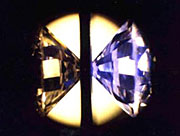- Number 295 |
- September 14, 2009
Hydrogen-rich material promises energy solutions

Researchers created material
under enormous pressures by
squeezing samples between two
diamonds. (Photo courtesy
Wendy Mao, SIMES.)
Researchers at the Stanford Institute for Materials and Energy Science, a joint institute of DOE's SLAC National Accelerator Laboratory and Stanford University, have produced a hydrogen-rich alloy that could provide insight into the properties of metallic hydrogen. The work is a step toward materials with revolutionary implications for energy science, enabling lossless power transmission, next-generation particle accelerators and even magnetic levitation.
Metallic hydrogen is a state of hydrogen predicted to form under ultra-high pressure. If achieved, it could function as a room-temperature superconductor—a material capable of conducting electricity with no resistance at temperatures above 0 degrees Celsius. But because the pressure required to make metallic hydrogen is so enormous—much greater the pressure experienced by materials in the center of the earth—researchers have had little luck in producing it.
To better understand how metallic hydrogen behaves, researchers are becoming increasingly interested in hydrogen-rich compounds that might have properties similar to those seen in pure hydrogen, but at more accessible pressures. One of the most promising candidates is called silane, which contains an atom of silicon bound to four atoms of hydrogen. The goal for the SIMES group was to study the properties of alloys composed of hydrogen and silane together.
The group found that the alloys solidified at much lower pressures than would be required for hydrogen alone, with the hydrogen-rich alloy forming a solid containing more than 99 percent hydrogen. They also discovered that even though the amount of silane in the hydrogen-rich sample was minimal, it had a dramatic effect on hydrogen-hydrogen interactions.
According to Shibing Wang, a SIMES graduate student and the lead author on the paper, the finding is significant because it could contribute to a better understanding of the properties of atoms in hydrogen alloys, which are commonly used in hydrogen storage and could have implications for hydrogen fuel storage.[Melinda Lee, 650.926.8547,
melinda.lee@slac.stanford.edu]
